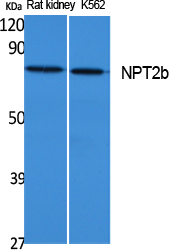NPT2b Polyclonal Antibody
- Catalog No.:YT5104
- Applications:WB;ELISA
- Reactivity:Human;Rat
- Target:
- NPT2b
- Fields:
- >>Parathyroid hormone synthesis, secretion and action;>>Mineral absorption
- Gene Name:
- SLC34A2
- Protein Name:
- Sodium-dependent phosphate transport protein 2B
- Human Gene Id:
- 10568
- Human Swiss Prot No:
- O95436
- Mouse Swiss Prot No:
- Q9DBP0
- Rat Swiss Prot No:
- Q9JJ09
- Immunogen:
- Synthesized peptide derived from NPT2b . at AA range: 630-710
- Specificity:
- NPT2b Polyclonal Antibody detects endogenous levels of NPT2b protein.
- Formulation:
- Liquid in PBS containing 50% glycerol, 0.5% BSA and 0.02% sodium azide.
- Source:
- Polyclonal, Rabbit,IgG
- Dilution:
- WB 1:500 - 1:2000. ELISA: 1:20000. Not yet tested in other applications.
- Purification:
- The antibody was affinity-purified from rabbit antiserum by affinity-chromatography using epitope-specific immunogen.
- Concentration:
- 1 mg/ml
- Storage Stability:
- -15°C to -25°C/1 year(Do not lower than -25°C)
- Other Name:
- SLC34A2;Sodium-dependent phosphate transport protein 2B;Sodium-phosphate transport protein 2B;Na(+)-dependent phosphate cotransporter 2B;NaPi3b;Sodium/phosphate cotransporter 2B;Na(+)/Pi cotransporter 2B;NaPi-2b;Solute carrier family 34 member 2
- Observed Band(KD):
- 75kD
- Background:
- The protein encoded by this gene is a pH-sensitive sodium-dependent phosphate transporter. Phosphate uptake is increased at lower pH. Defects in this gene are a cause of pulmonary alveolar microlithiasis. Three transcript variants encoding two different isoforms have been found for this gene. [provided by RefSeq, May 2010],
- Function:
- disease:Defects in SLC34A2 are a cause of pulmonary alveolar microlithiasis [MIM:265100]. Pulmonary alveolar microlithiasis is a rare disease characterized by the deposition of calcium phosphate microliths throughout the lungs. Most patients are asymptomatic for several years or even for decades and generally, the diagnosis is incidental to clinical investigations unrelated to the disease. Cases with early onset or rapid progression are rare. A 'sandstorm-appearing' chest roentgenogram is a typical diagnostic finding. The onset of this potentially lethal disease varies from the neonatal period to old age and the disease follows a long-term, progressive course, resulting in a slow deterioration of lung functions. Pulmonary alveolar microlithiasis is a recessive monogenic disease with full penetrance.,function:May be involved in actively transporting phosphate into cells via Na(+) cotransp
- Subcellular Location:
- Membrane; Multi-pass membrane protein.
- Expression:
- Highly expressed in lung. Also detected in pancreas, kidney, small intestine, ovary, testis, prostate and mammary gland. In lung, it is found in alveolar type II cells but not in bronchiolar epithelium.
- June 19-2018
- WESTERN IMMUNOBLOTTING PROTOCOL
- June 19-2018
- IMMUNOHISTOCHEMISTRY-PARAFFIN PROTOCOL
- June 19-2018
- IMMUNOFLUORESCENCE PROTOCOL
- September 08-2020
- FLOW-CYTOMEYRT-PROTOCOL
- May 20-2022
- Cell-Based ELISA│解您多样本WB检测之困扰
- July 13-2018
- CELL-BASED-ELISA-PROTOCOL-FOR-ACETYL-PROTEIN
- July 13-2018
- CELL-BASED-ELISA-PROTOCOL-FOR-PHOSPHO-PROTEIN
- July 13-2018
- Antibody-FAQs
- Products Images

- Western Blot analysis of extracts from rat kidney, K562 cells, using NPT2b Polyclonal Antibody. Secondary antibody(catalog#:RS0002) was diluted at 1:20000



